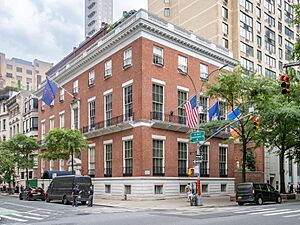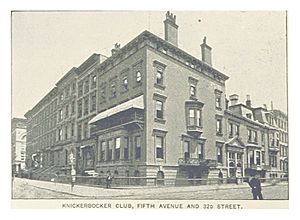Knickerbocker Club facts for kids

In 2024
|
|
| Formation | 1871 |
|---|---|
| Type | Private social club |
| Location | |
The Knickerbocker Club, often called The Knick, is a private social club in New York City. It was started in 1871. Many people think it is one of the most exclusive clubs in the United States. It is also seen as one of the most important gentlemen's clubs in the world.
The name "Knickerbocker" comes partly from the writer Washington Irving. He used the pen name Diedrich Knickerbocker. Over time, "Knickerbocker" became a way to describe old, important families in New York. It was similar to calling someone a "Boston Brahmin" in Boston.
History of The Knick

The Knickerbocker Club was founded in 1871. Some members of another club, the Union Club of the City of New York, started it. They felt that the Union Club's rules for who could join were not strict enough.
By the 1950s, fewer people were joining social clubs in cities. This was partly because many wealthy families moved to the suburbs.
The Knick's current building is at 2 East 62nd Street. It was designed in a style called neo-Georgian. Construction started in 1913 and finished in 1915. This building is now a city landmark.
Who Can Join?
Members of the Knickerbocker Club are mostly from very old, important families. These families often came from Britain and the Netherlands. Many of them were part of the first families in the Thirteen Colonies in the 1600s. Some also came from Europe for political reasons.
Later, in the mid-1900s, the club also welcomed some descendants of wealthy families from the Gilded Age. For example, members of the Rockefeller family joined.
Being very rich has never been the only way to join these special clubs. People and their families must also meet the club's standards for values and behavior. Old family wealth is often more important than new money. The Rockefeller family's story shows this. John D. Rockefeller, who started the family's wealth, joined a respectable but not top-level club. His son, John D. Rockefeller Jr., joined a slightly more exclusive club. Finally, his grandson, John D. Rockefeller III, was accepted into the Knickerbocker Club. This shows how new wealthy families could slowly become part of the highest social class over generations.
Famous Members
Many well-known people have been members of the Knickerbocker Club. Here are some of them:
- Charles Francis Adams III (1866–1954), a U.S. Ambassador. He was a great-grandson of U.S. President John Quincy Adams.
- His Royal Highness Amyn Aga Khan, a leader in the Nizari Ismaili faith.
- Gianni Agnelli (1921–2003), a major shareholder of Fiat and an Italian Senator.
- Winthrop W. Aldrich (1885–1974), a U.S. Ambassador to the United Kingdom.
- Arthur Balfour, 1st Earl of Balfour (1848–1930), a former Prime Minister of the United Kingdom.
- His Royal Highness Franz, Duke of Bavaria, head of the House of Wittelsbach.
- Count Folke Bernadotte of Wisborg (1895–1948), a diplomat and grandson of the King of Sweden. He helped release many prisoners during World War II.
- Anthony Joseph Drexel Biddle Jr. (1897–1961), a General and U.S. Ambassador to several countries.
- John Moors Cabot (1901–1981), a U.S. Ambassador to five nations.
- Adna Chaffee (1842–1914), a General and Chief of Staff of the U.S. Army. He fought in several wars.
- William A. Chanler (1867–1934), an explorer and politician. He was a descendant of Peter Stuyvesant, the last Dutch governor of New Netherland.
- Charles A. Coffin (1844–1926), who helped start General Electric.
- Calvin Coolidge (1872–1933), the 30th president of the United States.
- Pierre de Cossé Brissac, 12th Duke of Brissac (1900–1993), a French aristocrat and author.
- Harvey Cushing (1869–1939), a famous neurosurgeon who pioneered brain surgery.
- Richard Henry Dana Jr. (1815–1882), a lawyer and author of Two Years Before the Mast.
- Angier Biddle Duke (1915–1995), a U.S. Ambassador and Chief of Protocol. He was from the wealthy Duke family.
- T. S. Eliot (1888–1965), a Nobel Prize-winning poet and playwright.
- William Crowninshield Endicott (1826–1900), a U.S. Secretary of War.
- Frederick Theodore Frelinghuysen (1817–1885), a U.S. Secretary of State.
- Ogden Goelet (1851–1897), a wealthy yachtsman. His daughter married a Duke.
- Count Florian Henckel von Donnersmarck, a German film director known for The Lives of Others.
- His Imperial Highness Friedrich Wilhelm, Prince of Hohenzollern (1924–2010), head of the Imperial House of Hohenzollern.
- Peter Augustus Jay (1877–1933), a U.S. Ambassador. He was a great-great-great-grandson of John Jay, the first U.S. Chief Justice.
- Woodbury Kane (1859–1905), a yachtsman and member of Theodore Roosevelt's Rough Riders.
- Amos A. Lawrence (1814–1886), a key figure in the movement to end slavery in the U.S.
- His Serene Highness Prince Edouard de Lobkowicz (1926–2010), an Austrian-American Ambassador and banker.
- Henry Cabot Lodge Jr. (1902–1985), a U.S. Ambassador and politician.
- A. Lawrence Lowell (1856–1943), a President of Harvard University.
- Paul Mellon (1907–1999), a philanthropist and horse breeder. He was an heir to a large business fortune.
- George Minot (1885–1950), a Nobel Prize winner in Medicine.
- J. P. Morgan (1837–1913), a famous banker and financier. He left the club and started the Metropolitan Club of New York.
- Marquis Guy-Philippe de Montebello, a director of the Metropolitan Museum of Art.
- Edward N. Ney (1925–2014), a U.S. Ambassador.
- Kichisaburo Nomura (1877–1964), a Japanese ambassador.
- Charles Jackson Paine (1833–1916), a railroad executive and General in the Union Army.
- The Lord Palumbo, a property developer and art collector.
- Wendell Phillips (1811–1884), an American who fought to end slavery.
- George P. Putnam (1887–1950), a publisher and explorer. He was married to Amelia Earhart.
- His Serene Highness Prince Dominik Radziwiłł (1911–1976), head of the House of Radziwiłł.
- Laurance Rockefeller (1910–2004), a financier and conservationist. He was a grandson of John D. Rockefeller.
- David Rockefeller (1915–2017), a banker and chairman of Chase Manhattan Corporation. He was also a grandson of John D. Rockefeller.
- His Imperial Highness Prince Alexander Romanov (1929–2002), a member of the Imperial House of Romanov.
- Theodore Roosevelt Sr. (1831–1878), father of President Theodore Roosevelt. He helped found the Knickerbocker Club.
- Franklin D. Roosevelt (1882–1945), a President of the United States. He joined the club in 1903 and left in 1936.
- Baron Guy de Rothschild (1909–2007), a famous banker and head of the French branch of the Rothschild family.
- Leverett Saltonstall (1892–1979), a U.S. Senator.
- John Singer Sargent (1856–1925), a leading portrait painter.
- His Imperial Highness Zera Yacob Amha Selassie, the current head of the Imperial House of Ethiopia.
- Count Alexander von Stauffenberg (1905–1964), a German aristocrat and historian.
- Augustus Van Horne Stuyvesant Jr. (1870–1953), the last direct descendant of Peter Stuyvesant, the Dutch governor of New Netherland.
- Baron David Swaythling (1928–1998), a member of the House of Lords and chairman of several British companies.
- Nathaniel Thayer III (1851–1911), an American banker and railroad executive.
- Baron Hans Heinrich Thyssen-Bornemisza (1921–2002), a well-known industrialist and art collector.
- Cornelius Vanderbilt III (1873–1942), a general and member of the wealthy Vanderbilt family.
- Harold Stirling Vanderbilt (1884–1970), a railroad executive and yachtsman, also from the Vanderbilt family.
- Alexander Van Rensselaer (1850–1933), a philanthropist and tennis player.
- Baron Egon von Vietinghoff-Scheel (1903–1994), a German-Swiss painter and philosopher.
- Craig Wadsworth (1872–1960), a diplomat and member of Theodore Roosevelt's Rough Riders.
- Henry White (1850–1927), a U.S. Ambassador who signed the Treaty of Versailles.
- Robert Winthrop (1833–1892), a banker and descendant of colonial governors.
- Jerauld Wright (1898–1995), a high-ranking U.S. Navy officer.
Other Clubs They Work With
The Knickerbocker Club has special agreements with other clubs around the world. This means their members can often visit these other clubs. Some of these clubs include:
- Jockey Club in Paris, France
- Cercle Royal du Parc in Brussels, Belgium
- Metropolitan Club in Washington D.C., USA
- Boodle's in London, England
- Brooks's in London, England
- New Club in Edinburgh, Scotland
- Norske Selskab in Oslo, Norway
- Australian Club in Sydney, Australia
- Kildare Street & University Club in Dublin, Ireland
- Somerset Club in Boston, USA
- York Club in Toronto, Canada
See also
- List of gentlemen's clubs in the United States
- List of New York City Designated Landmarks in Manhattan from 59th to 110th Streets


